Everyone needs a star project in their life. I’m not talking just about kids, and nerds like me who are into astronomy. There’s something primal about looking at the stars at night inside all of us. It connects us with our ancestors and how they felt when they looked at the night sky and dreamed about what’s out there.
But wouldn’t it be cool to be able to watch the stars while staying inside with a blanket and a nice cup of tea or hot chocolate? enter star projectors.
Fast picks
If you want to skip all the explanations and you just want to know which star projector you should get, here are our three selections. If you want the complete guide, keep reading below.
| Best Overall | Best for mood lighting | Best for education |
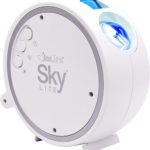 BlissLights Sky Lite |  GLOUE Pro Star |  NatGeo Astro Planetarium |
Table of Contents
What Is A Star Projector?
Star Projectors are devices the project a beam of light across the room to show images of space into a wall or some other (preferably) flat surface.
In essence, the technology behind star projectors is quite simple. They are not too different from regular projectors.
The main difference between a star project and a regular projector is that the most advanced star projectors have a spherical shape that allows the light beam to better approximate the spherical shape of the sky. This is the same reason why the theaters at planetariums are shaped like a dome.
Star projectors are also generally way cheaper than projectors.
Sometimes star projectors are also known as home planetariums.
Benefits Of Star Projectors
Star Projectors are not only fun, but they also have some benefits that are not obvious and you might not expect. As an adult and astronomy nerd that has used one for years and has gifted several to nephews and nieces, here are some of the pros of owning one:
- Star projectors are relaxing and can help you to fall asleep faster.
- They function as night lamps, so they are great for small children who still want to keep a light on at night.
- Some star projectors, double as white noise machines. Studies have found white noise can help in getting better sleep.
- They serve as learning tools, helping you memorize the names and positions of stars, constellations, planets, and other objects in the sky.
- If you are an adult, they can be used to help create a romantic ambient in a room. Try it next time you cook for someone.
- They are relatively cheap and generally last for a long time.
- Some models come with Bluetooth speakers included so you can sync your phone or they come with relaxing music pre-loaded.
- Some of the spherical models also include a “party mode” that allows them to project colors and shapes that work great as party mood lighting.
- Modern projectors use very little power. In the 5W-8W range.
Types Of Star Projectors
There are two main types of projectors in the market:
Mood Light Projectors
These devices only project small dots of light to simulate stars and some other spacey patterns that look like galaxies, nebulas, planets, etc. These projectors are not made to accurately reflect the position of stars in the sky, they are just for lighting/mood purposes.
These are the types of star projectors that also double as party lighting and generally have other types of fun patterns and colors, but don’t expect to learn anything from them.
They are generally cheaper than home planetariums and are great if you are only looking for something that looks like stars and space but you don’t really care about the accuracy of the projection.
Home Planetariums
These are the type of projectors that actually make an effort to reflect the position of stars and constellations in the sky. They can include labels or pointers to indicate what are you looking at exactly.
Because just like in real life, you can’t look at all the stars that are visible from Earth at the same time, home planetariums only display a portion of the night sky, but they fix that limitation by letting you switch between displays so you can look at the other parts of the firmament. Most of the high-end projectors of this type do this by using small, translucent discs that you can switch in and out when you want to change the visualization. They’ll generally include two basic discs that show the sky in both of Earth’s hemispheres and sell other discs separately.
How To Use A Star Projector
Using a star projector is very simple. Even kids should be able to operate them without the need of adult supervision.
They usually have at least 3 controls:
On\Off – Toggles the power between on and off.
Visualization – Toggles between the different visualization patterns
Rotation – Most decent projectors have some sort of rotation that allows them to make it look like the stars or patterns are moving. This control will turn rotation on or off.
The most advanced projectors will include controls for their unique features, such as turning the white noise on/off, enabling the speakers, or setting a sleep timer so that it automatically turns off after a few minutes, just like the tv timers.
As for home planetariums, they will have at least a button to eject/close the disc tray and change the direction of the display.
Some modern star projectors can be charged via USB and can operate for a few hours on battery. For others you will have to keep the plugged to function.
Price Ranges
Most consumer star projectors range between the following price groups:
$20-$60: In this range, you will find basic projectors with low to medium resolution and basic features. This is the recommended price range for entry-level users, nurseries, 3-5 years old kids bedrooms.
$60-$100: For this price, you can generally get either a star projector with advanced features or a mid-range home planetarium. This is the range you are looking at if you are looking for something for older kids, educational purposes, or adults.
$100-$200: In this group, you will find the most advanced planetariums that come with all the bells and whistles. These are only recommended if you are really into astronomy or if the price tag is not a problem for you.
Best Star Projectors
I have personally reviewed and tested more than 30 of the best selling and best rated star projectors in the market. Additionally, the list has been kept up to date whenever new projectors are launch, even though to be honest, the technology hasn’t really changed much in the last few years. Only minor quality of life changes like USB-C support and improved battery life have been added in the recent times.
We came up with the 5 best options, each of them excels in a certain area or price range so you can find the one that fits your needs best.
National Geographic Astro Planetarium
Best pick for: Education
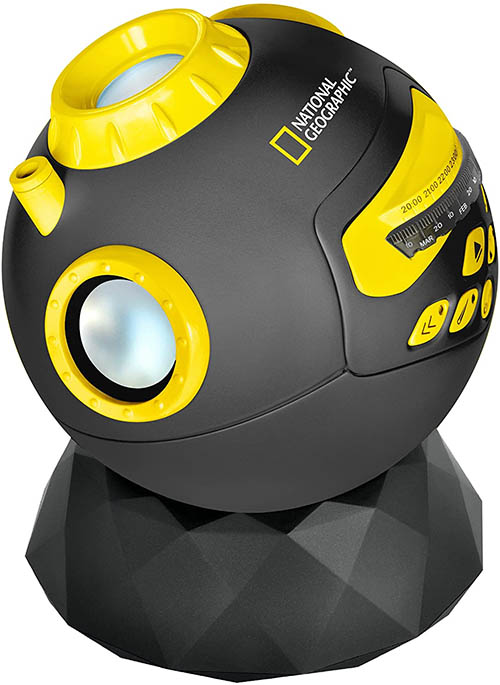
We have talked about NatGeo’s line of products before. They license and brand some educational type of products like telescopes or binoculars. They usually have quality products in the mid-range area and this home planetarium is no exception.
The Astro Planetarium is a spherical device where you can load the included discs to choose the projection you want. It uses a small motor to rotate and simulate star movement.
The coolest features for this advanced planetarium is the ability to select any date of the year using the controls in the back, and it will automatically adjust the projection to show the stars that would be visible in the sky on that day.
The constellations in the included discs are traced by lines to make it easier to recognize and learn.
It comes with all the features of advanced planetariums while keeping a reasonable price.
It also comes with built-in speakers that can be used with the built-in FM radio or any device you want to connect like your phone.
Pros:
- Real stars and constellation position
- High-quality projection
- Date control
- Built-in speakers
Cons:
- Battery life could be improved
- I wish the build quality could be a bit less “toy-like”
BlissLights Sky Lite
Best pick for: all-around
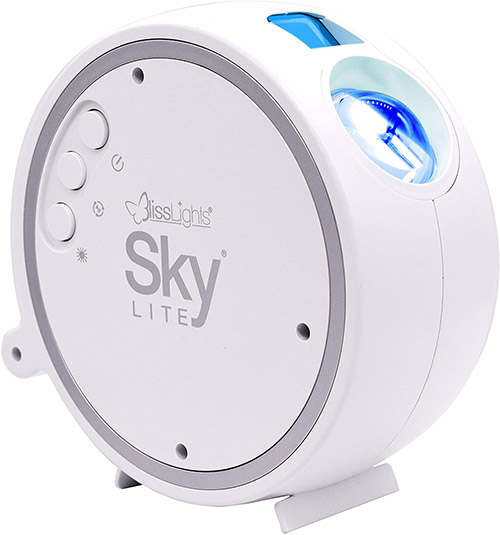
The Blisslights Sky Lite is probably the most complete star projector in the market in its price range. It offers everything you could be looking for: multiple visualizations that range from soothing to party-like, rotation capabilities, sleep timer, high-quality optics, and dim control.
The one thing that made me trust the brand before buying it and convinced me is BlissLights is actually a special effects company in San Diego that used to do lighting for theme parks, theaters and other venues. They know what they are doing when it comes to lighting effects.
The build quality is great and while I’ve only had mine for a few months, it looks like it can last for a long time.
If you don’t need a realistic display of the stars, this is the star projector I’d recommend to a friend asking which one should they get.
I got the white version. There is a black version of this that I believe has a different array of visualization, but don’t quote on this as I was not able to personally test that model.
Pros:
- Every feature you might need.
- Reasonably priced for the features.
- Designed by lighting experts.
Cons:
- I just wish it came with remote control.
GLOUE Pro Star Projector
Best pick for: Party/mood lighting
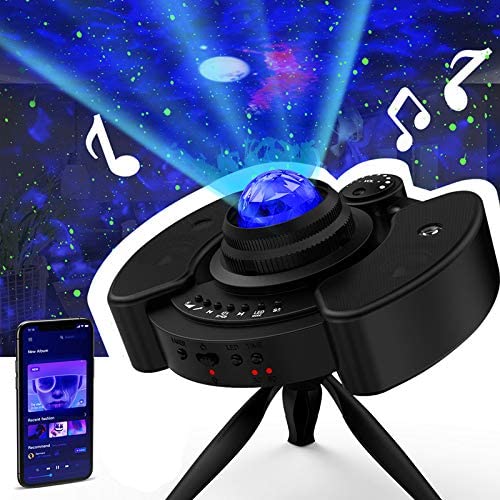
If you are looking for a projector for parties, dinners, or mood lighting in general, the Pro Star Projector by GLOUE has all the features for that.
First, there’s the spherical design of the projection that allows it to project the image to 360 degrees so the whole room is illuminated.
It also includes a bluetooth speaker that while it is not the best in terms of sound fidelity, is better than what you would expect out of a device of its size.
But the coolest feature about this little device, and the one that makes it earn this recommendation, is the semi-smart flicker functionality, that when activated, flashes the light trying to match the rhythm of the music. I call it semi-smart because it is definitely not a perfect match, but it is as good as any of those music visualizer apps.
On top of that, it has all of the other features you would expect from a projector, such as sleep timer, brightness adjustment, and auto-rotation.
Pros:
- 360°Rotational Projector
- Flicker mode
- Built-in speakers
- Excellent price
Cons:
- Build quality could be improved, the tripod feels a bit fragile
Galaxy Projector
Best pick for: Smart homes
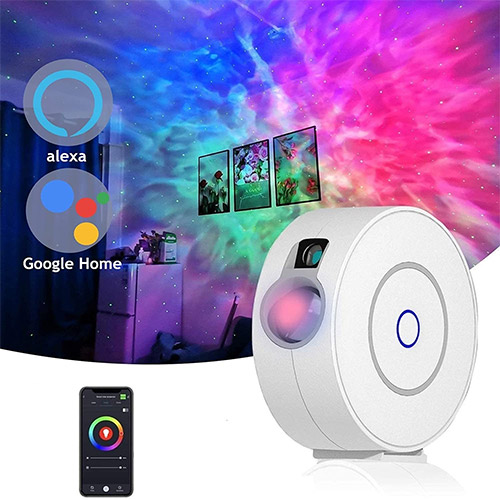
All the features of these projectors seem great, you say, but in modern times, wouldn’t it be cool if it could function as part of your smart home setup and could connect to Alexa or Google Home.
Well, here you go.
The Galaxy Projector includes all the basic features from other projectors, but on top of that, it can be voice controlled through Alexa and Google Home. It also comes with its own app to adjust color hues, brightness, and other settings.
Pros:
- Alexa and Google home connectivity
- Adjustable direction
- Quiet operation
Cons:
- The app tends to act weird sometimes.
- No 360 rotation.
Homestar Classic
Best pick for: High-end planetarium
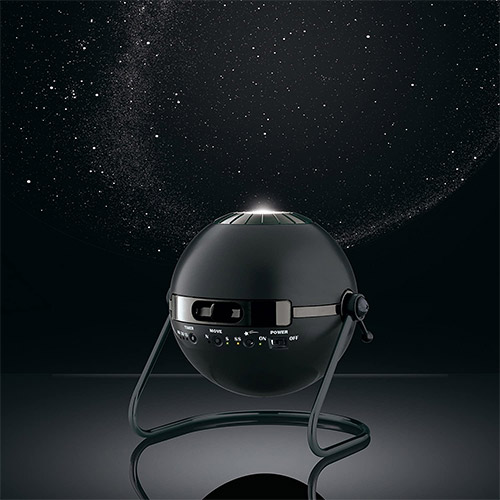
If money is no problem and what you want is to really replicate the planetarium experience at home, oh boy, here’s the pick for you.
Homestar is a sub-brand of space related toys created by the Japanese company Sega Toys. Yes, the same Sega from the Sega Genesis gaming console for you 80s and 90s kids.
The Homestar classic is their flagship product and is quite simply the second best home planetarium in the market, only beaten by its big brother the Homestar Flux, but for some reason that one is quite hard to find outside Japan so I’m recommending the Classic instead.
The discs come with more than 60,000 stars in their correct positions and the peripheral motor functionality make looking at them a great experience.
There are two versions of this in the market. The one we are linking below is the correct European version because the U.S. has been out of stock for a while. This version does require a European power adapter that is not included so be aware of that before buying.
Pros:
- Spectacular display
- Accurate star positions
- High end features
Cons:
- It is a bit pricey
Enjoyed this article?
Get daily 10-minute PDFs about astronomy to read before bed!
Sign up for our upcoming micro-learning service where you will learn something new about space and beyond every day while winding down.







